The United States Treasury Secretary Janet Yellen expressed optimism about the progress of the Group of Seven (G7) meeting, expecting the G7 to utilize future proceeds from freezing Russian assets to aid Ukraine. The G7 leaders are expected to make a decision on this measure at the June summit.
Yellen stated in an interview with Bloomberg on Friday (May 24) that despite important technical issues that still need to be resolved, there was a positive attitude towards the overall approach in the discussions.
Currently, G7 finance ministers and central bank governors are meeting in Stresa, Italy. Yellen mentioned during the meeting break, “I feel very good about our conversations.”
As the Russian military offensive intensifies, the focus of Western countries has shifted towards providing longer-term mid-term assistance to Kyiv and sending a strong signal to Moscow that the G7 allies are committed to supporting Ukraine.
The United States has been advocating for the G7 to utilize the future benefits from Russia’s $280 billion foreign exchange reserves. Following Russia’s full-scale invasion of Ukraine in February 2022, these foreign exchange reserves have been frozen by Western countries.
The G7 hopes to use the significant profits generated in the future from these Russian assets as collateral to provide up to $500 billion in loans to Ukraine. Yellen mentioned that she believes implementing this plan does not require approval from Congress.
Finance ministers of the G7 will discuss this plan in detail on Saturday to develop a framework for the G7 leaders to decide on at the next month’s summit.
According to a draft communiqué obtained by Bloomberg (which is subject to change), finance ministers will state that they have discussed potential options to utilize the proceeds from frozen assets and reaffirm their position that these funds will remain frozen until Russia pays for Ukraine’s reconstruction.
While progress has been made in the discussions of the plan, many critical technical details are still being negotiated, including the specific mechanisms of the loans, the amount to be raised upfront, and the management and distribution of the funds.
Crucially, the G7 needs to reach a consensus on how to share the risks, which is also a major concern for the European Union as most of the frozen assets are within the EU.
If the war ends and Russia and Ukraine reach a peace agreement with Moscow agreeing to cover the costs of Ukraine’s reconstruction, it will raise questions about whether the assets will continue to be frozen and how to ensure the collateral for the loans if they are unfrozen.
Yellen downplayed this possibility and emphasized that these assets are likely to remain frozen for some time.
Nevertheless, she expressed willingness to share risks with G7 allies, stating, “One feasible approach is to share risks in proportion to the amount people provide for the loans.”
Approximately €210 billion (US$228 billion) worth of Russian frozen assets are in the EU, with most of them held in Euroclear.
The EU recently passed an agreement to allow Euroclear to reinvest the cash proceeds from these assets and provide the investment gains as aid to Ukraine. According to this agreement, Europe can transfer €2.5 to €3 billion in earnings to Kyiv each year.
The first installment is scheduled to be paid in July this year, with 90% of it allocated for purchasing weapons and military equipment.

